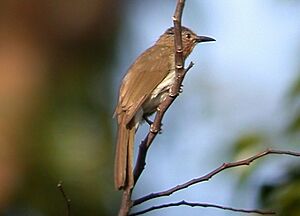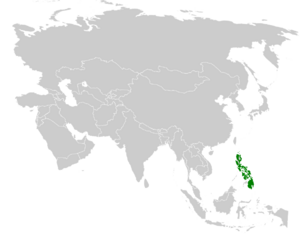Philippine bulbul facts for kids
Quick facts for kids Philippine bulbul |
|
|---|---|
 |
|
| Conservation status | |
| Scientific classification | |
 |
|
| Synonyms | |
|
The Philippine bulbul (scientific name: Hypsipetes philippinus) is a small, chirpy songbird. It belongs to the bulbul family, called Pycnonotidae. This special bird lives only in the Philippines, which means it is an endemic species there. You can find it in warm, wet forests, both in lowlands and on mountains. For example, on Mount Kitanglad in Mindanao, lots of these birds live in untouched forests, from about 500 to 2,250 meters above sea level.
Contents
About the Philippine Bulbul
What is Taxonomy?
Taxonomy is like a big filing system for all living things. Scientists use it to name and group animals and plants based on how they are related. The Philippine bulbul has had a few different names over the years. It was first put in the group Turdus, then Ixos. In 2010, scientists decided it fit best in the group Hypsipetes. This is because it is very similar to the black bulbul, which is the main example for the Hypsipetes group.
Different Kinds of Philippine Bulbuls
Before 2010, some other bulbuls, like the Mindoro bulbul, Visayan bulbul, and Zamboanga bulbul, were thought to be just different types (subspecies) of the Philippine bulbul. Now, they are considered their own separate species.
Currently, there are three recognized subspecies of the Philippine bulbul:
- H. p. parkesi: This type is found on Burias island.
- H. p. philippinus: This is the main type, found in the northern parts of the Philippines.
- H. p. saturatior: This type lives in the eastern-central and southern Philippines.
Life and Habits
Breeding and Young Birds
Philippine bulbuls have a long breeding season. Young birds, called fledglings, were seen on Mindanao in late April. However, female birds ready to lay eggs were still found in April and May. This suggests they might have babies at different times of the year. You can hear their songs at lower altitudes as late as May. Higher up in the mountains, the birds are quieter around that time, likely busy raising their young.
Predators and Safety
Sometimes, other birds of prey, like the besra (a type of goshawk), hunt young Philippine bulbuls. These goshawks might also catch adult birds.
Conservation Status
The Philippine bulbul is a common bird that can adapt well to its surroundings, as long as there is enough forest left. Because of this, the IUCN (International Union for Conservation of Nature) does not consider it a threatened species. This means it is not currently in danger of disappearing.


